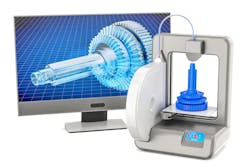3D printing, also known as additive manufacturing, creates solid objects from a digital file, with the ability to produce complex shapes, including hollow forms. The technology has advanced far from its beginnings in the ‘90s as a rapid prototyping medium, to a viable cog in industrial manufacturing. Here are a few snippets about recent developments in this rapidly changing technology:
GE Partners with U.S. Air Force for Printing Spare Engine Parts
General Electric has successfully 3D-printed the sump cover for the F110 jet engine. Initially cast from aluminum, the part, also used on F-15 and F-16 jet fighters, was the focus for this first phase of the collaboration. Engineers at GE Aviation’s Cincinnati-area Additive Technology Center (ATC) created the parts from cobalt-chrome powder, using GE Additive’s Concept Laser M2 machine. “Part of that process involved how metal additive might replace parts that are either no longer in production, or where we need smaller production runs to keep our platforms flying,” explained Melanie Jonason, chief engineer for the propulsion sustainment division at Tinker Air Force Base in Oklahoma.1
Human-Like Ears 3D-Printed Inside Mice
Scientist Maling Gou and colleagues at Sichuan University, China, have grown human-like ears on the backs of mice. The technique could be used to create body parts for people without resorting to surgery. Up to now, spare human body parts have been printed outside the body, then surgically implanted, which carries a risk for infection. In this experiment, the researchers injected a “bio-ink” into the backs of mice, which was subjected to near-infrared light in the pattern of a human ear, which caused the hydrogel ink particles to solidify and develop, in layers, into human ear structures. Within a month, cartilage cells grew around the structures. The researchers said that the mice suffered no inflammation or side effects. An intent of the study is to create ears for humans born without ears, a condition called microtia. According to Derek Rosenzweig at McGill University in Canada, this printing technique has potential in repairing damaged cartilage in noses, fingers, toes, or elbows. Rosenzweig said that using the technique on hip and deep knee cartilage would be a special challenge, because near-infrared light penetrates only 2 centimeters into the body.2
Coronavirus Spurs Use of 3D Printing
Emergency responders have been faced with finding enough face shields for protection during the COVID-19 coronavirus disaster. Fortunately, major defense contractors such as Raytheon Technologies have been able to contribute what they know in three-dimensional (3D) printing, to form thousands of secure face shields for first responders and other emergency crew members.
“It was unprecedented to bring the entire corporation together to print one single file across multiple processes and materials using somewhere around 100 machines in less than two weeks,” said Jesse Boyer, fellow for additive manufacturing at Raytheon Technologies. “To ramp up to that volume that quickly is something that is touted using additive manufacturing, but rarely demonstrated. The opportunity was a great learning experience.”
Instead of cutting or molding material, 3D printing, or additive manufacturing, creates a part by building layer upon layer to form the desired shape. This approach can provide extremely efficient shapes and sizes that also work well where space is at a premium, such as in aircraft. “The wild side is to continue to do that, to make very complex, yet optimized structures for areas we couldn’t normally do in a jet engine,” Boyer said. “We explore methods like bio-mimicry, by looking at the best nature has produced. Additive then reduces the constraints of conventional manufacturing and substantially increases our ability to optimize what we can manufacture.”3
